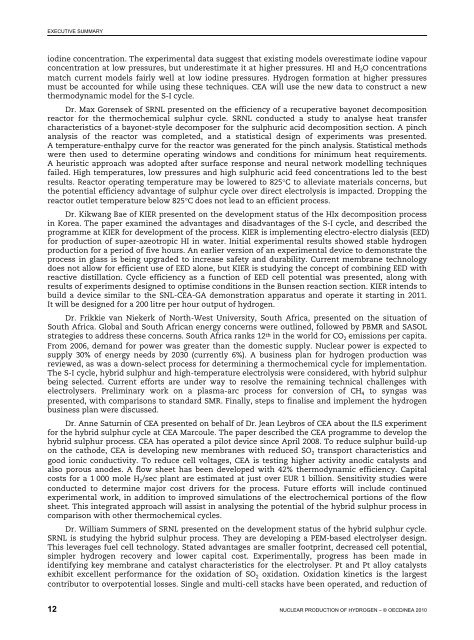Nuclear Production of Hydrogen, Fourth Information Exchange ...
Nuclear Production of Hydrogen, Fourth Information Exchange ...
Nuclear Production of Hydrogen, Fourth Information Exchange ...
Create successful ePaper yourself
Turn your PDF publications into a flip-book with our unique Google optimized e-Paper software.
EXECUTIVE SUMMARY<br />
iodine concentration. The experimental data suggest that existing models overestimate iodine vapour<br />
concentration at low pressures, but underestimate it at higher pressures. HI and H 2 O concentrations<br />
match current models fairly well at low iodine pressures. <strong>Hydrogen</strong> formation at higher pressures<br />
must be accounted for while using these techniques. CEA will use the new data to construct a new<br />
thermodynamic model for the S-I cycle.<br />
Dr. Max Gorensek <strong>of</strong> SRNL presented on the efficiency <strong>of</strong> a recuperative bayonet decomposition<br />
reactor for the thermochemical sulphur cycle. SRNL conducted a study to analyse heat transfer<br />
characteristics <strong>of</strong> a bayonet-style decomposer for the sulphuric acid decomposition section. A pinch<br />
analysis <strong>of</strong> the reactor was completed, and a statistical design <strong>of</strong> experiments was presented.<br />
A temperature-enthalpy curve for the reactor was generated for the pinch analysis. Statistical methods<br />
were then used to determine operating windows and conditions for minimum heat requirements.<br />
A heuristic approach was adopted after surface response and neural network modelling techniques<br />
failed. High temperatures, low pressures and high sulphuric acid feed concentrations led to the best<br />
results. Reactor operating temperature may be lowered to 825°C to alleviate materials concerns, but<br />
the potential efficiency advantage <strong>of</strong> sulphur cycle over direct electrolysis is impacted. Dropping the<br />
reactor outlet temperature below 825°C does not lead to an efficient process.<br />
Dr. Kikwang Bae <strong>of</strong> KIER presented on the development status <strong>of</strong> the HIx decomposition process<br />
in Korea. The paper examined the advantages and disadvantages <strong>of</strong> the S-I cycle, and described the<br />
programme at KIER for development <strong>of</strong> the process. KIER is implementing electro-electro dialysis (EED)<br />
for production <strong>of</strong> super-azeotropic HI in water. Initial experimental results showed stable hydrogen<br />
production for a period <strong>of</strong> five hours. An earlier version <strong>of</strong> an experimental device to demonstrate the<br />
process in glass is being upgraded to increase safety and durability. Current membrane technology<br />
does not allow for efficient use <strong>of</strong> EED alone, but KIER is studying the concept <strong>of</strong> combining EED with<br />
reactive distillation. Cycle efficiency as a function <strong>of</strong> EED cell potential was presented, along with<br />
results <strong>of</strong> experiments designed to optimise conditions in the Bunsen reaction section. KIER intends to<br />
build a device similar to the SNL-CEA-GA demonstration apparatus and operate it starting in 2011.<br />
It will be designed for a 200 litre per hour output <strong>of</strong> hydrogen.<br />
Dr. Frikkie van Niekerk <strong>of</strong> North-West University, South Africa, presented on the situation <strong>of</strong><br />
South Africa. Global and South African energy concerns were outlined, followed by PBMR and SASOL<br />
strategies to address these concerns. South Africa ranks 12 th in the world for CO 2 emissions per capita.<br />
From 2006, demand for power was greater than the domestic supply. <strong>Nuclear</strong> power is expected to<br />
supply 30% <strong>of</strong> energy needs by 2030 (currently 6%). A business plan for hydrogen production was<br />
reviewed, as was a down-select process for determining a thermochemical cycle for implementation.<br />
The S-I cycle, hybrid sulphur and high-temperature electrolysis were considered, with hybrid sulphur<br />
being selected. Current efforts are under way to resolve the remaining technical challenges with<br />
electrolysers. Preliminary work on a plasma-arc process for conversion <strong>of</strong> CH 4 to syngas was<br />
presented, with comparisons to standard SMR. Finally, steps to finalise and implement the hydrogen<br />
business plan were discussed.<br />
Dr. Anne Saturnin <strong>of</strong> CEA presented on behalf <strong>of</strong> Dr. Jean Leybros <strong>of</strong> CEA about the ILS experiment<br />
for the hybrid sulphur cycle at CEA Marcoule. The paper described the CEA programme to develop the<br />
hybrid sulphur process. CEA has operated a pilot device since April 2008. To reduce sulphur build-up<br />
on the cathode, CEA is developing new membranes with reduced SO 2 transport characteristics and<br />
good ionic conductivity. To reduce cell voltages, CEA is testing higher activity anodic catalysts and<br />
also porous anodes. A flow sheet has been developed with 42% thermodynamic efficiency. Capital<br />
costs for a 1 000 mole H 2 /sec plant are estimated at just over EUR 1 billion. Sensitivity studies were<br />
conducted to determine major cost drivers for the process. Future efforts will include continued<br />
experimental work, in addition to improved simulations <strong>of</strong> the electrochemical portions <strong>of</strong> the flow<br />
sheet. This integrated approach will assist in analysing the potential <strong>of</strong> the hybrid sulphur process in<br />
comparison with other thermochemical cycles.<br />
Dr. William Summers <strong>of</strong> SRNL presented on the development status <strong>of</strong> the hybrid sulphur cycle.<br />
SRNL is studying the hybrid sulphur process. They are developing a PEM-based electrolyser design.<br />
This leverages fuel cell technology. Stated advantages are smaller footprint, decreased cell potential,<br />
simpler hydrogen recovery and lower capital cost. Experimentally, progress has been made in<br />
identifying key membrane and catalyst characteristics for the electrolyser. Pt and Pt alloy catalysts<br />
exhibit excellent performance for the oxidation <strong>of</strong> SO 2 oxidation. Oxidation kinetics is the largest<br />
contributor to overpotential losses. Single and multi-cell stacks have been operated, and reduction <strong>of</strong><br />
12 NUCLEAR PRODUCTION OF HYDROGEN – © OECD/NEA 2010

















